Hydrologic Performance of an Extensive Green Roof in Syracuse, NY
Abstract
1. Introduction
2. Materials and Methods
2.1. Study Site Details
2.2. Syracuse Climate and Precipitation
2.3. Monitoring System and Data Collection
2.4. Data Analysis
2.4.1. Event Analysis
- (1)
- No precipitation for 6 h prior to the start of an event, and
- (2)
- Runoff from any previous event must have ceased prior to the start of an event.
2.4.2. Event Plot Statistical Analysis
2.4.3. Evapotranspiration Analysis
3. Results and Discussion
3.1. Weather during the Study Period
3.2. Green Roof Performance
3.2.1. Performance by Event Size
3.2.2. Performance by Season
3.3. Evapotranspiration
4. Conclusions
Author Contributions
Funding
Acknowledgments
Conflicts of Interest
References
- National Research Council. Introduction: Urbanization and its impacts. In Urban Stormwater Management in the United States; The National Academies Press: Washington, DC, USA, 2009; pp. 13–20. [Google Scholar]
- United States Environmental Protection Agency (USEPA). Reported to Congress: Impacts and Control of CSOs and SSOs; No. EPA 833-R-04-001; USEPA: Washington, DC, USA, 2004.
- National Research Council. Stormwater Management Approaches. In Urban Stormwater Management in the United States; The National Academies Press: Washington, DC, USA, 2009; pp. 339–474. [Google Scholar]
- Li, Y.; Babcock, R.W. Green roof hydrologic performance and modeling: A review. Water Sci. Technol. 2014, 69, 727–738. [Google Scholar] [CrossRef] [PubMed]
- O’Connor, T.P.; Culligan, P.J.; Carson, T.; Gaffin, S.; Gibson, R.; Hakimdavar, R.; Hsueh, D.; Hunter, N.; Marasco, D.; McGillis, W. Evaluation of Green Roof Water Quantity and Quality Performance in an Urban Climate; US EPA Office of Research and Development: Washington, DC, USA, 2014; pp. 1–79.
- Fassman-Beck, E.; Voyde, E.; Simcock, R.; Hong, Y.S. 4 Living roofs in 3 locations: Does configuration affect runoff mitigation. J. Hydrol. 2013, 490, 11–20. [Google Scholar] [CrossRef]
- Fioretti, R.; Palla, A.; Lanza, L.G.; Principi, P. Green roof energy and water related performance in the Mediterranean climate. Build. Environ. 2010, 45, 1890–1904. [Google Scholar] [CrossRef]
- Hakimdavar, R.; Culligan, P.J.; Finazzi, M.; Barontini, S.; Ranzo, R. Scale dynamics of extensive green roofs: Quantifying the effect of drainage area and rainfall characteristics on observed and modeled green roof hydrologic performance. Ecol. Eng. 2014, 73, 494–508. [Google Scholar] [CrossRef]
- Nawaz, R.; McDonald, A.; Postoyko, S. Hydrological performance of a full-scale extensive green roof located in a temperate climate. Ecol. Eng. 2015, 82, 66–80. [Google Scholar] [CrossRef]
- Mentens, J.; Raes, D.; Hermy, M. Green roofs as a tool for solving the rainwater runoff problem in the urbanized 21st century? Landsc. Urban Plan. 2006, 77, 217–226. [Google Scholar] [CrossRef]
- Schroll, E.; Lambrinos, J.; Righetti, T.; Sandrock, D. The role of vegetation in regulating stormwater runoff from green roofs in a winter rainfall climate. Ecol. Eng. 2011, 37, 595–600. [Google Scholar] [CrossRef]
- Spolek, G. Performance monitoring of three ecoroofs in Portland, Oregon. Urban Ecosyst. 2008, 11, 349–359. [Google Scholar] [CrossRef]
- Speak, A.F.; Rothwell, J.J.; Lindley, S.J.; Smith, C.L. Rainwater runoff retention on an aged intensive green roof. Sci. Total Environ. 2013, 461–462, 28–38. [Google Scholar] [CrossRef]
- Penn State University Agricultural Analytical Services Laboratory, Test Package GR01A; University Park: Centre County, PA, USA, 2011.
- Yang, Y.; Davidson, C.I. Green roof performance influenced by growth medium characteristics. In Proceedings of the 15th Annual New York State Green Building Conference, Syracuse, NY, USA, 30–31 March 2017. [Google Scholar]
- Squier, M.; Davidson, C.I. Heat flux and seasonal thermal performance of an extensive green roof. Build. Environ. 2016, 107, 235–244. [Google Scholar] [CrossRef]
- Kottek, M.; Grieser, J.; Beck, C.; Rudolf, B.; Rubel, F. World map of the Köppen-Geiger climate classification updated. Meteorol. Z. 2006, 15, 259–263. [Google Scholar] [CrossRef]
- Andrews, F.; Guillaume, J. Hydromad: Hydrological Model Assessment and Development. 2016, R Package Version 0.9-26. Available online: http://hydromad.catchment.org/ (accessed on 25 May 2020).
- National Centers for Environmental Information, Climate Data Online. Available online: www.ncdc.noaa.gov (accessed on 6 August 2016).
- Razzaghmanesh, M.; Beecham, S. The hydrological behavior of extensive and intensive green roofs in a dry climate. Sci. Total Environ. 2014, 499, 284–296. [Google Scholar] [CrossRef] [PubMed]
- Stovin, V. The potential of green roofs to manage Urban Stormwater. Water Environ. J. 2010, 24, 192–199. [Google Scholar] [CrossRef]
- Wong, G.K.L.; Jim, C.Y. Quantitative hydrologic performance of extensive green roof under humid tropical rainfall regime. Ecol. Eng. 2014, 70, 366–378. [Google Scholar] [CrossRef]
- Van Spengen, J. The Effects of Large-Scale Green Roof Implementation on the Rainfall-Runoff in a Tropical Urbanized Catchment. Master’s Thesis, Delft University of Technology, Delft, The Netherlands, 2010. [Google Scholar]
- Carson, T.B.; Marasco, D.E.; Culligan, P.J.; McGillis, W.R. Hydrological performance of extensive green roofs in New York City: Observations and multi-year modeling of three full-scale systems. Environ. Res. Lett. 2013, 8, 1–13. [Google Scholar] [CrossRef]
- Tukey, J.W. Exploratory Data Analysis; Addison-Wesley: Boston, MA, USA, 1977. [Google Scholar]
- McGill, R.; Tukey, J.W.; Larsen, W.A. Variations of box plots. Am. Stat. 1978, 32, 12–16. [Google Scholar]
- Wickham, H. ggplot2: Elegant Graphics for Data Analysis; Springer-Verlag: New York, NY, USA, 2016. [Google Scholar]
- Northeast Regional Climate and Natural Resources Conservation Center. Extreme Precipitation in New York & New England: An Interactive Web Tool for Extreme Precipitation Analysis. Available online: Precip.eas.cornell.edu (accessed on 6 August 2016).
- Abualfaraj, N.; Cataldo, J.; Elborolosy, Y.; Fagan, D.; Woerdeman, S.; Carson, T.; Montalto, F.A. Monitoring and modeling the long-term rainfall runoff response of the Jacob K. Javits Center green roof. Water 2018, 10, 1494. [Google Scholar] [CrossRef]
- Hathaway, A.M.; Hunt, W.F.; Jennings, G.D. A field study of green roof hydrologic and water quality performance. Trans. ASABE 2008, 1, 37–44. [Google Scholar] [CrossRef]
- Kurtz, T. Flow monitoring of three ecoroofs in Portland, Oregon. In Proceedings of the Low Impact Development for Urban Ecosystem and Habitat Protection, Seattle, WA, USA, 16–19 November 2008; pp. 1–10. [Google Scholar]
- Liu, K.; Minor, J. Performance Evaluation of an Extensive Green Roof; NRCC-48204; National Research Council Canada: Ottawa, ON, Canada, 2005; pp. 1–11. [Google Scholar]
- Voyde, E.; Fassman, E.; Simcock, R.; Wells, J. Quantifying evapotranspiration rates for New Zealand Green Roofs. J. Hydrol. Eng. 2010, 15, 395–403. [Google Scholar] [CrossRef]
- Johannessen, B.G.; Muthanna, T.M.; Braskerud, B.C. Detention and retention behavior of four extensive green roofs in three Nordic climate zones. Water 2018, 10, 671. [Google Scholar] [CrossRef]
- Liu, X.; Chui, T.F.M. Evaluation of green roof performance in mitigating the impact of extreme storms. Water 2019, 11, 815. [Google Scholar] [CrossRef] [PubMed]
- Gong, Y.; Yin, D.; Fang, X.; Li, J. Factors affecting runoff retention performance of extensive green roofs. Water 2018, 10, 1217. [Google Scholar] [CrossRef]
- Sims, A.W.; Robinson, C.E.; Smart, C.C.; O’Carroll, D.M. Mechanism controlling green roof peak flow rate attenuation. J. Hydrol. 2019, 577, 1–13. [Google Scholar] [CrossRef]
- Stovin, V.; Vesuviano, G.; Kasmin, H. The hydrological performance of a green roof test bed under UK climate conditions. J. Hydrol. 2012, 414–415, 148–161. [Google Scholar] [CrossRef]
- Stovin, V.; Vesuviano, G.; De-Ville, S. Defining green roof detention performance. Urban Water J. 2017, 14, 574–588. [Google Scholar] [CrossRef]
- Dingman, S.L. Stream Response to Water Input Events. In Physical Hydrology, 2nd ed.; Prentice Hall: Upper Saddle River, NJ, USA, 2002; pp. 389–456. [Google Scholar]
- Elliott, R.M.; Gibson, R.A.; Carson, T.B.; Marasco, D.E.; Culligan, P.J.; McGillis, W.R. Green roof seasonal variation: Comparison of the hydrologic behavior of a thick and a thin extensive system in New York City. Environ. Res. Lett. 2016, 11, 074020. [Google Scholar] [CrossRef]
- Yang, Y.; Davidson, C.I. Quantifying Evapotranspiration on a Green Roof: A Comparison of Soil Water Balance Method with Common Predictive Methods. 2020; under review. [Google Scholar]
- Marasco, D.E.; Hunter, B.N.; Culligan, P.J.; Gaffin, S.R.; McGillis, W.R. Quantifying evapotranspiration from urban green roofs: A comparison of chamber measurements with commonly used predictive methods. Environ. Sci. Technol. 2014, 48, 10273–10281. [Google Scholar] [CrossRef]
- DiGiovanni, K.; Montalto, F.; Gaffin, S.; Rosenzweig, C. Applicability of Classical Predictive Equations for the Estimation of Evapotranspiration from Urban Green Space: Green Roof Results. J. Hydrol. Eng. 2013, 18, 99–107. [Google Scholar] [CrossRef]
- Starry, O.; Lea-Cox, J.D.; Kim, J.; van Iersel, M.W. Photosynthesis and water use by two Sedum species in green roof substrate. Environ. Exp. Bot. 2014, 107, 105–112. [Google Scholar] [CrossRef]


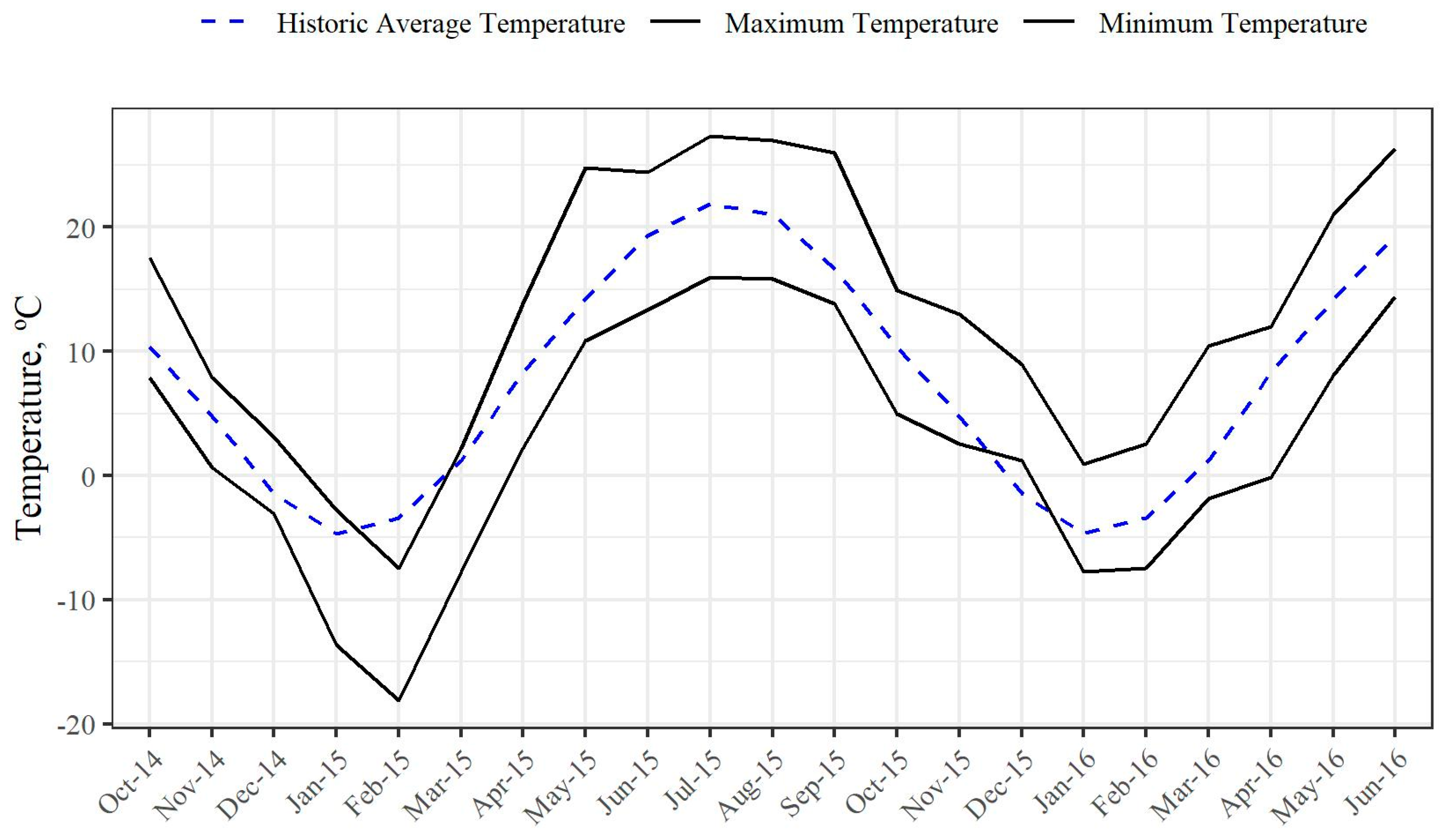


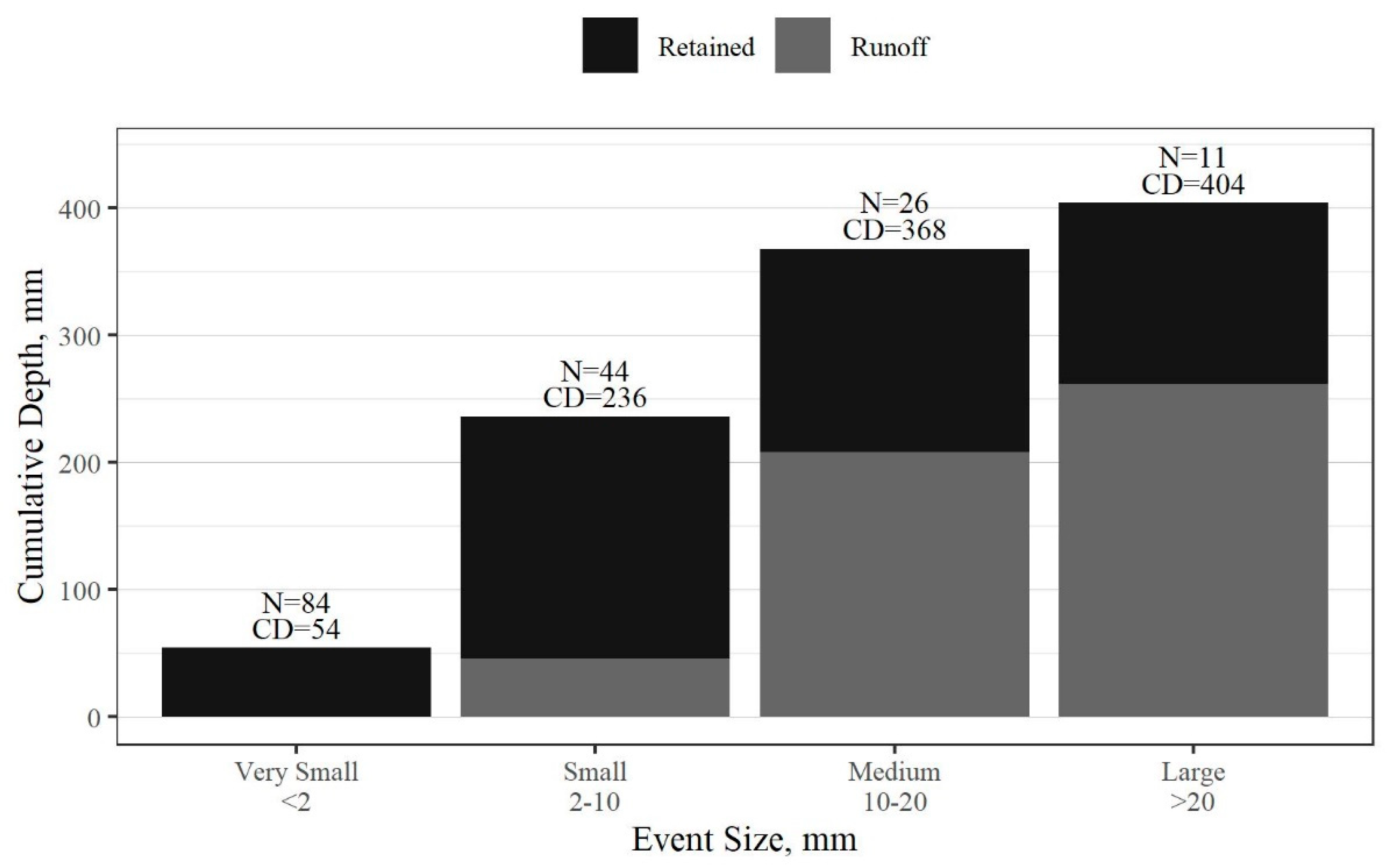
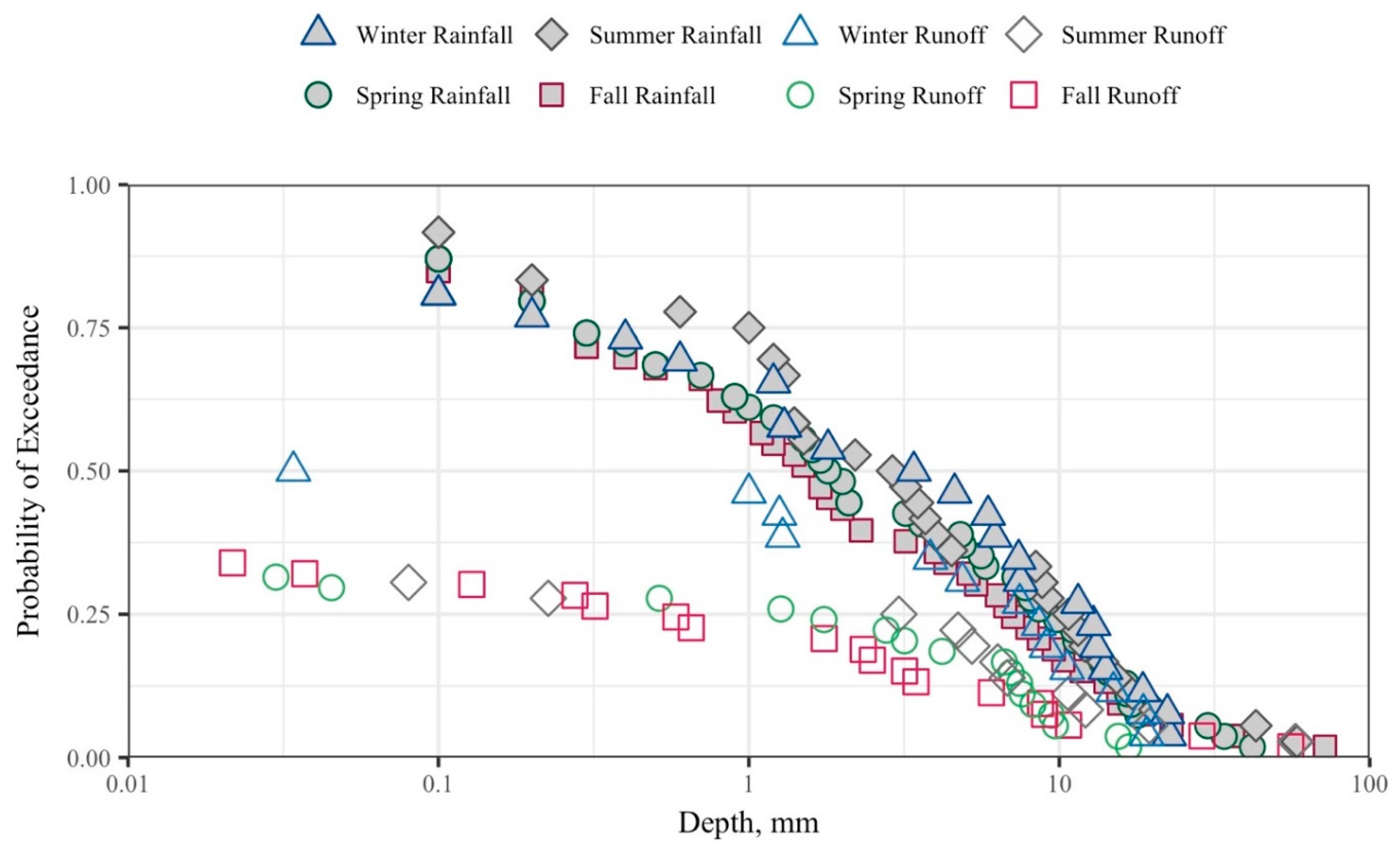
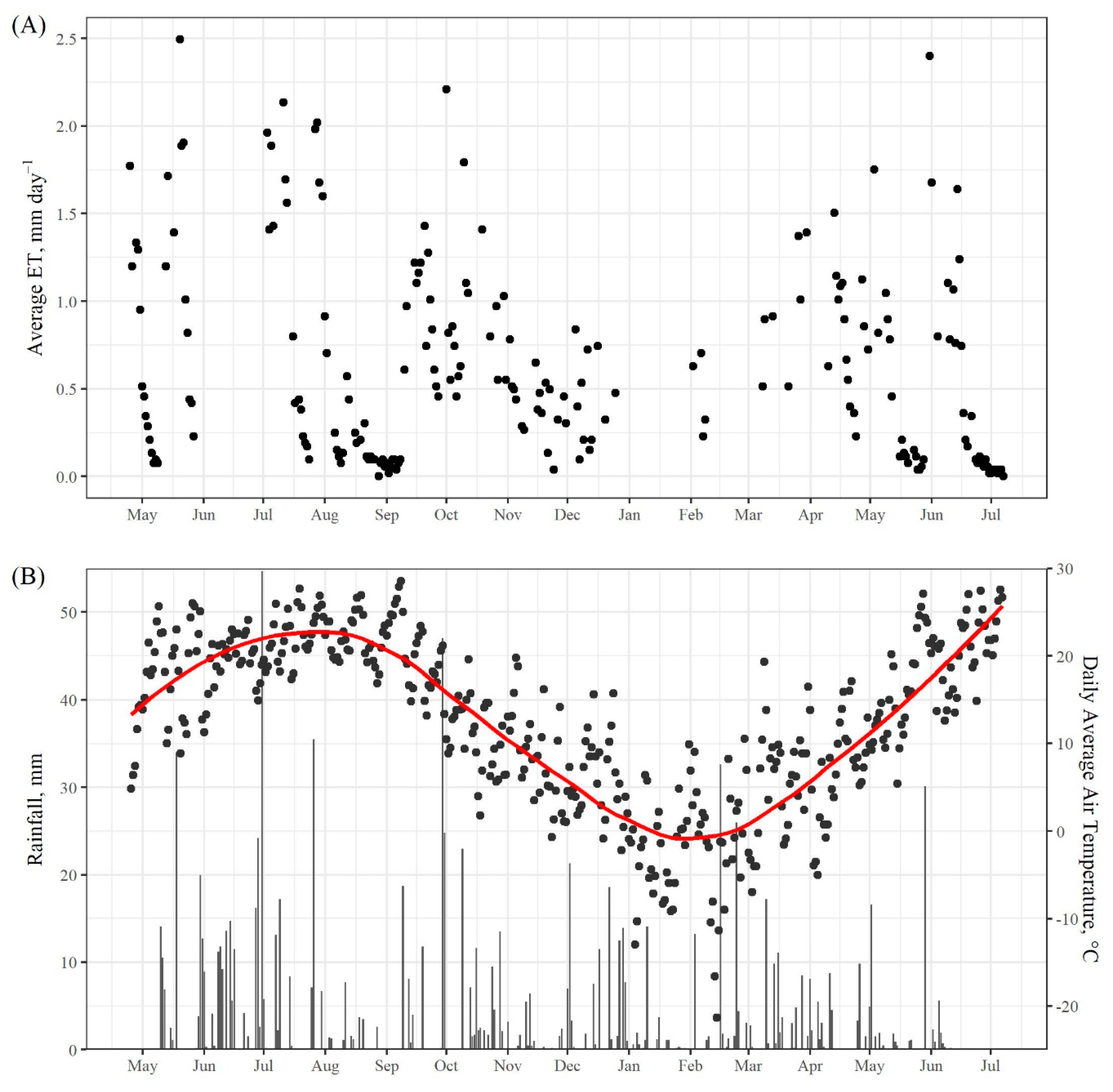
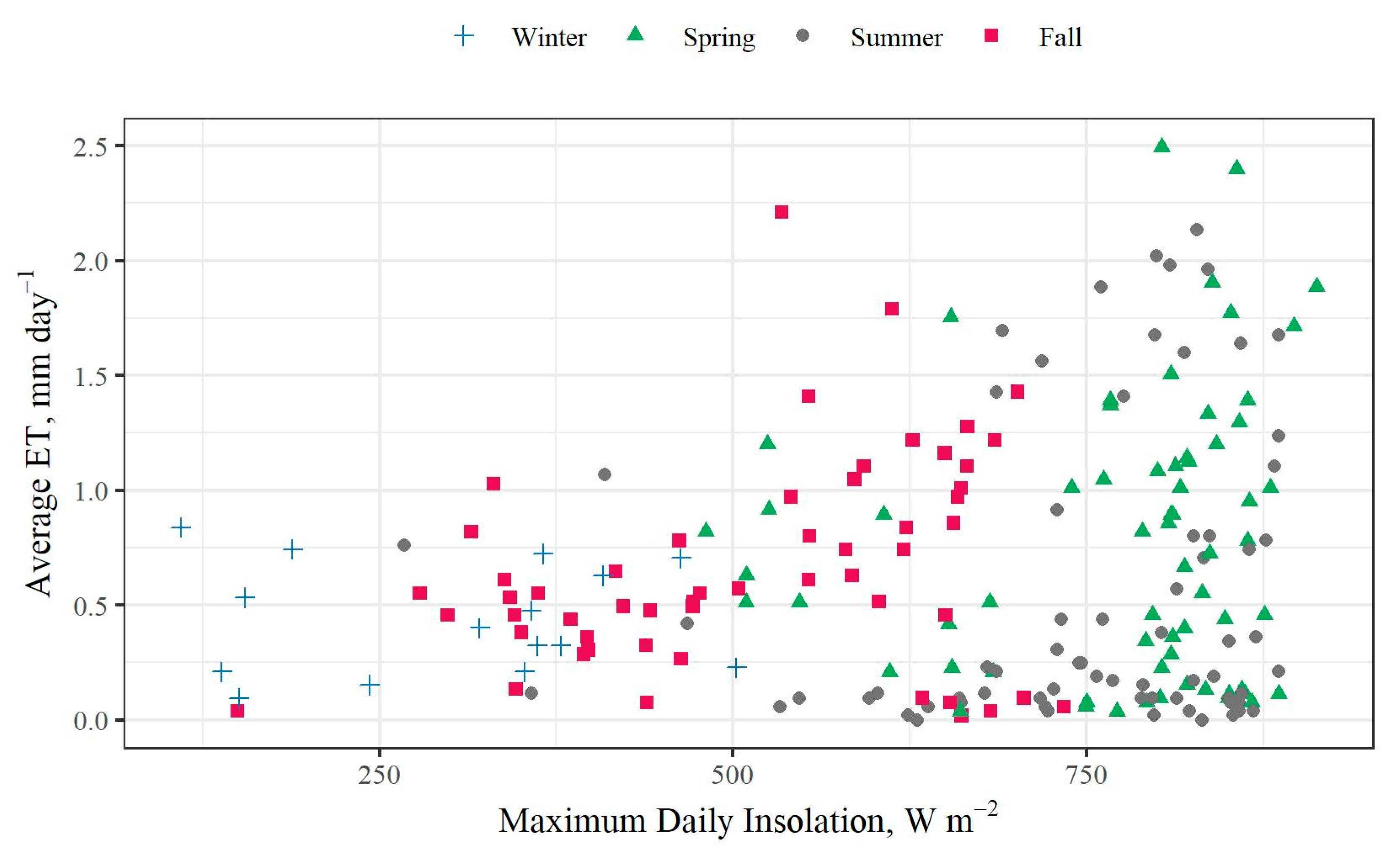
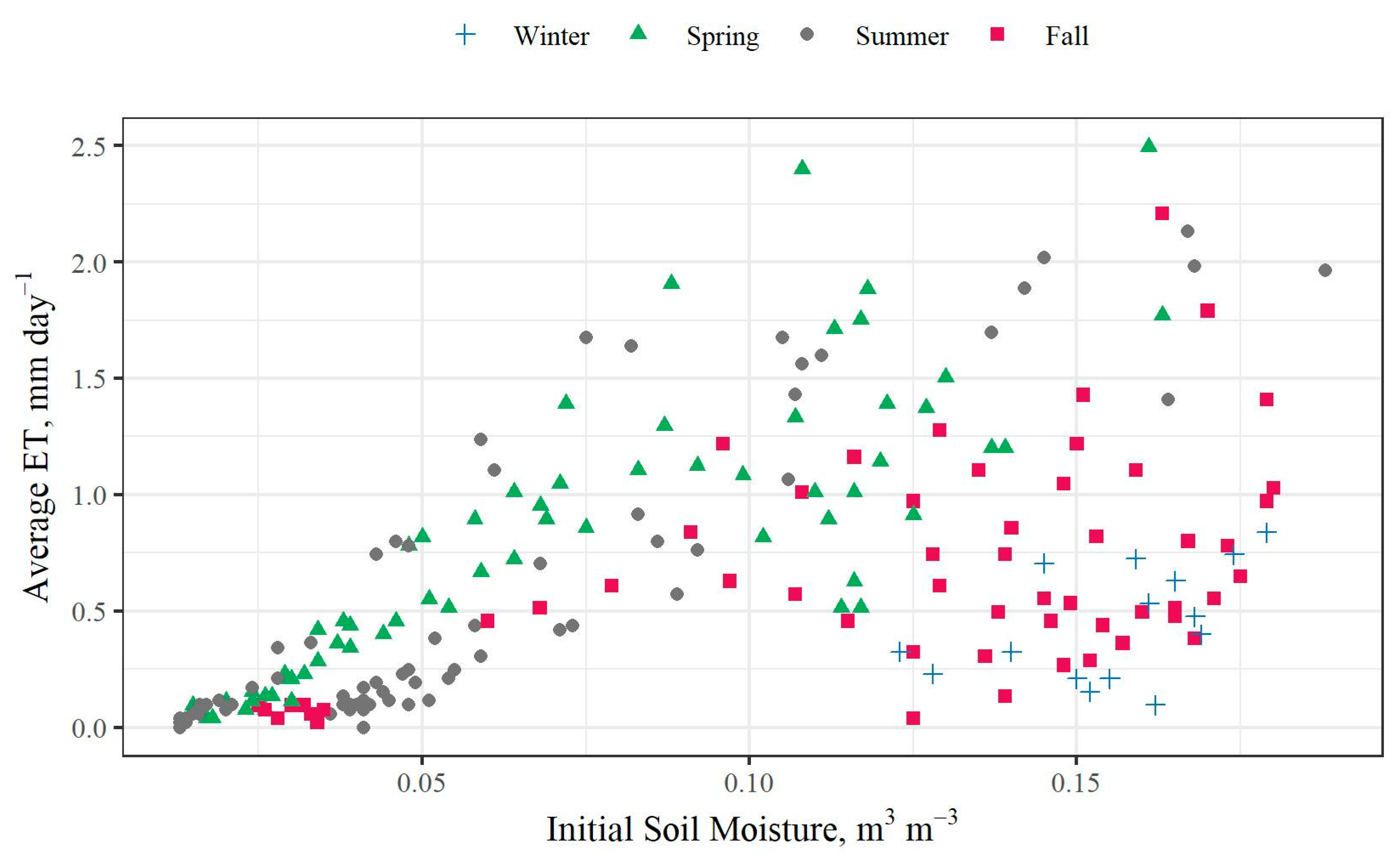
| Metric | Minimum | Maximum | Average | Median |
|---|---|---|---|---|
| Peak Delay, h | −0.92 | 30 | 3.3 | 0.75 |
| Centroid Delay, h | 0.18 | 17 | 3.2 | 2.5 |
| Peak Attenuation, mm/5 min | 0.11 | 5.2 | 1.3 | 0.68 |
| Peak Runoff, mm/5 min | 0.01 | 1.4 | 0.31 | 0.26 |
| Time to Start, h | 0 | 12 | 3.6 | 2.8 |
| Runoff Duration, h | 0.5 | 48 | 13 | 11 |
| Start Date and Time | Rain Depth, mm | Retention Depth, mm | Initial Soil Moisture, m3 m−3 |
|---|---|---|---|
| 15 October 2014 11:15 | 36.3 | 7.46 | 0.084 |
| 18 May 2015 17:00 | 34 | 17.3 | 0.038 |
| 30 May 2015 17:30 | 41.9 | 26.4 | 0.019 |
| 14 June 2015 16:30 | 20.3 | 8.15 | 0.120 |
| 27 June 2015 14:00 | 43 | 23.5 | 0.040 |
| 30 June 2015 19:45 | 58.3 | 0.615 | 0.148 |
| 29 September 2015 11:00 | 71.8 | 16.1 | 0.040 |
| 9 October 2015 1:45 | 23 | 12.3 | 0.075 |
| 1 December 2015 23:15 | 22.3 | 3.16 | 0.157 |
| 29 December 2015 11:45 | 22.6 | 3.9 | 0.158 |
| 29 May 2016 13:30 | 30.1 | 23.1 | 0.017 |
| Season | Seasonal Retention | Rainfall | Event Count | Average Intensity | |||
|---|---|---|---|---|---|---|---|
| Event Average, % | Cumulative, mm | Depth, mm | Full Capture | Total | Event Mean, mm·h−1 | Event Peak, mm·h−1 | |
| Fall | 89.2 | 141 | 310 | 34 | 52 | 0.654 | 4.12 |
| Winter | 70.1 | 44.5 | 158 | 12 | 25 | 0.479 | 2.45 |
| Spring | 88.7 | 160 | 329 | 36 | 53 | 0.525 | 4.92 |
| Summer | 85.3 | 93 | 265 | 24 | 35 | 1.01 | 8.17 |
© 2020 by the authors. Licensee MDPI, Basel, Switzerland. This article is an open access article distributed under the terms and conditions of the Creative Commons Attribution (CC BY) license (http://creativecommons.org/licenses/by/4.0/).
Share and Cite
Squier-Babcock, M.; Davidson, C.I. Hydrologic Performance of an Extensive Green Roof in Syracuse, NY. Water 2020, 12, 1535. https://doi.org/10.3390/w12061535
Squier-Babcock M, Davidson CI. Hydrologic Performance of an Extensive Green Roof in Syracuse, NY. Water. 2020; 12(6):1535. https://doi.org/10.3390/w12061535
Chicago/Turabian StyleSquier-Babcock, Mallory, and Cliff I. Davidson. 2020. "Hydrologic Performance of an Extensive Green Roof in Syracuse, NY" Water 12, no. 6: 1535. https://doi.org/10.3390/w12061535
APA StyleSquier-Babcock, M., & Davidson, C. I. (2020). Hydrologic Performance of an Extensive Green Roof in Syracuse, NY. Water, 12(6), 1535. https://doi.org/10.3390/w12061535





